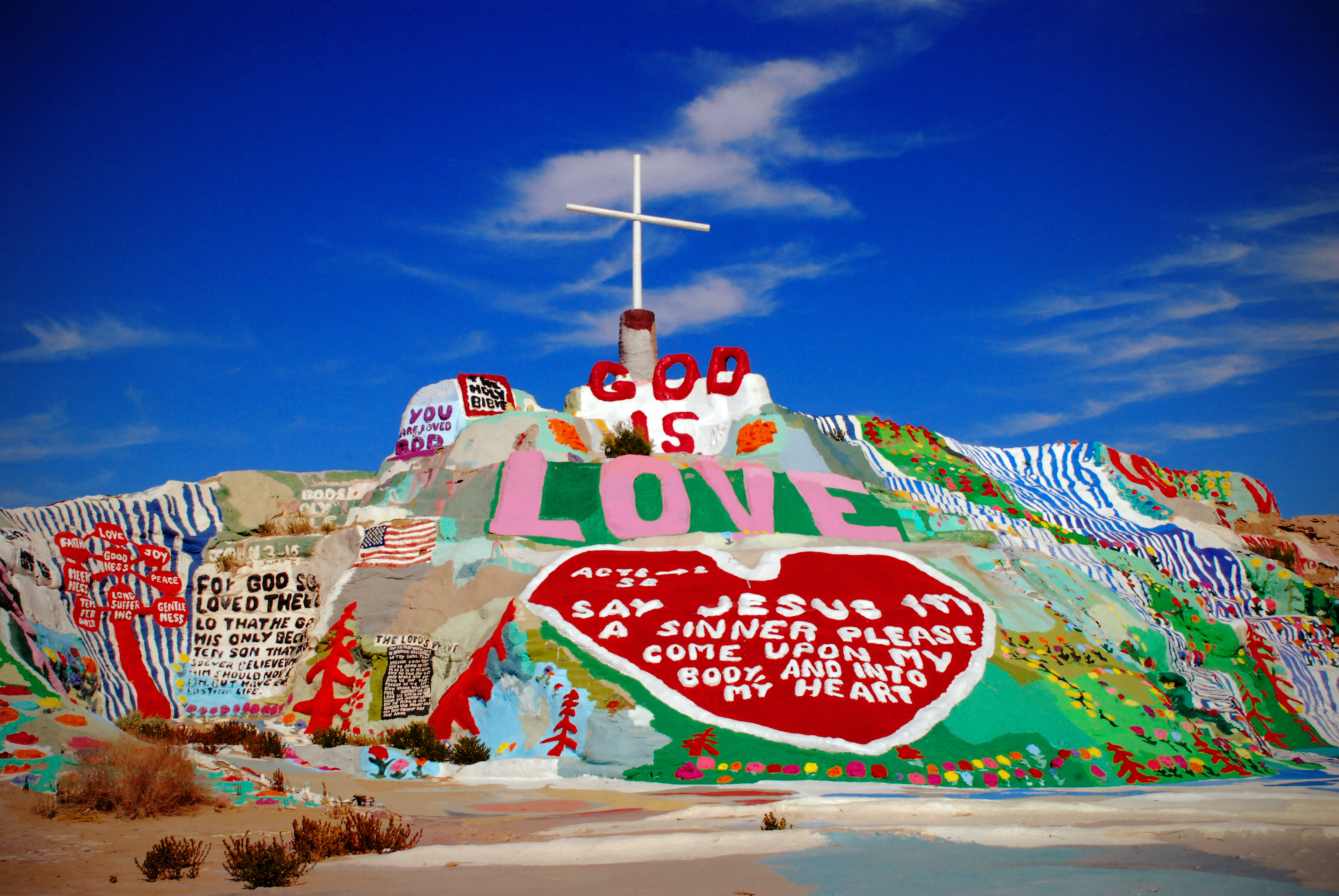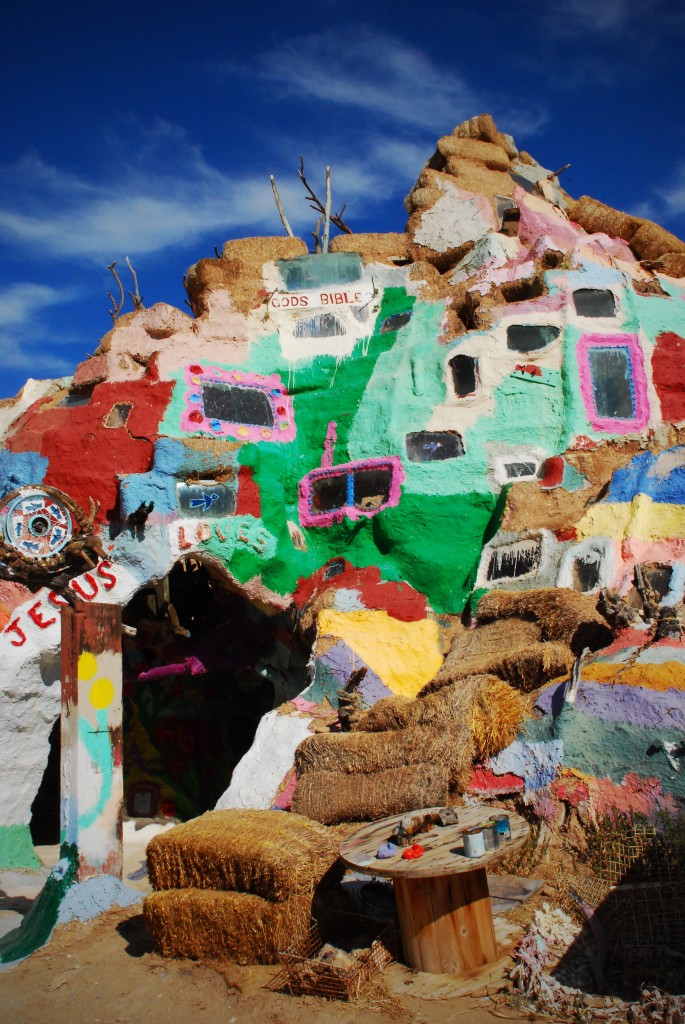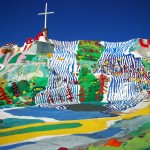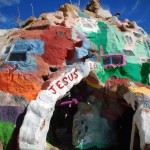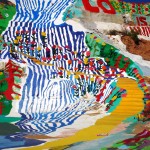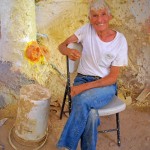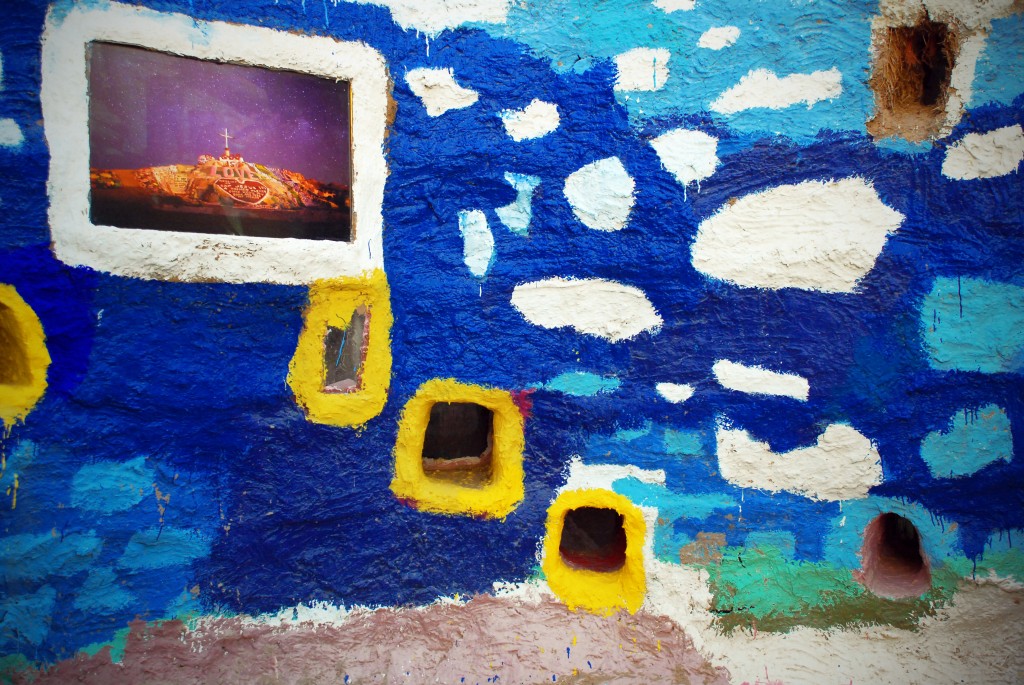Article and photos by Heather Quinn
“There’s going to be a worldwide love story coming down, universal. Love’s going to come down and it’s going to stomp all over hate. Hate is a losing proposition–it’s not as big as love. Total love is going to come down, and I see it coming. God! I see it coming!” -Leonard Knight, 11/1/31 – 2/10/14
(1)
Oh I’ve got a story to tell you
You’ll never listen to one word
Nobody ever listens
To a little hobo bird
– Song by Leonard Knight
This desert, the Colorado Basin in the southeastern corner of California, is known for its illusions. The appearance of water pooled up in dips along the long straight highways through this valley is so realistic that on occasion I have slammed on my brakes, only to find myself coasting through empty air. People have seen all sorts of things out here. Spanish galleons and Viking ships floating across imaginary expanses of water, tangible enough that people still look for their ruins. Tall trees on barren plains where cholla cacti and scrawny, low-hanging greasewoods are the only breaks on the flat horizon. Entire mountains disappear upon approach. “Who of the desert has not spent his day riding at a mountain and never even reaching its base?“ wondered John Van Dyke, a writer who explored this same desert in 1898. “This is a land of illusions and thin air.” But one particular mountain, which rises in a riot of color out of the horizontal sepia landscape, covered in trees and wet, shining flowers on fat yellow stalks, is not an illusion. Its waterfalls and pools of bright blue water are what I would imagine, if I had such an imagination, if I was dying of thirst in the 120 degree heat. But it’s not a mirage. It’s a dream.
This dreamscape is a living world that consists of a huge mound of mud coated in every possible color in hundreds of thousands of gallons of shining acrylic paint, a sculpture of a mountain that hugs a natural hillside, appearing to emerge organically from it, mirroring its natural curves. At its center is a giant heart of the deepest scarlet, framed in white, bearing instructions in white lettering: SAY JESUS I’M A SINNER PLEASE COME INTO MY BODY AND INTO MY HEART. On either side, waterfalls, painted in thick, vertical white and blue stripes, cascade down sheer sides, splitting into streams that surround forests of multicolored trees and grass and flowers in various hues and shapes. Flowers shaped like crude starbursts with bending arms. Flowers that up close are mere craters of a fist punched into soft yielding clay and coated with thick paint. Flowers that rise like sea anemones on fleshy stalks, supporting crowns of tentacle-like petals. Religious slogans are surrounded and supported by the lushness of this vibrant natural scene, lushness watered by painted streams in the desert. JESUS. FIRE. THE HOLY BIBLE. FOR GOD SO LOVED THE WORLD. And biggest of all, underneath a giant white cross at the peak, the most important one: GOD IS LOVE, in red and pink and so large and three dimensional that a child can sit comfortably cradled in the under curve of G and climb through the top loop of O. Threading up and around the top of the mountain is a yellow road with softly rounded built-in steps lined with flowers, slightly slippery, which move adventurous explorers up the curve of the hill, across the waterfalls, and straight behind the GOD to a platform with a western view across the whole desert valley.
Salvation Mountain stands at the entrance to Slab City, a makeshift community of desert loners, hermits, and eccentrics squatting on the remaining concrete foundations of Camp Dunlap, a Marine training base decommissioned in 1961. The mountain itself is three stories high and about 100 feet wide. The Slabs are four miles outside of the tiny desert town of Niland, which sits at the intersection of Highway 111 and the Union Pacific tracks that run south to north through the valley. Really, there isn’t much else to see out here. To get to the mountain, you’ve got to drive out on a poorly maintained county road, past fields irrigated with Colorado River water that sometimes overflow their drainage onto depressions in the asphalt. You might see a Slabber or two hiking the four miles back from town, provisions from the local grocery and general store gripped in either hand, and you might offer them a ride back to the Slabs if they don’t look too wild and wooly. It’s desolation all around, all khaki and gray with a few spots of subdued drab green from creosote and mesquite bushes. On one side of the road you pass a solar collection plant, the glint of sun on mirrors flashing through slats in the fence. You cross over the Highline Canal, a thin artery of muddy river water branching off of the larger concrete-lined Coachella Canal that runs alongside the Slabs. Otherwise, there’s not much to look at. Then the mountain comes into view, colored like candy or a melting ice-cream sundae, a shock of saturation in a monochromatic scene.
The mountain is made entirely of adobe–desert clay dug out of the surrounding hillside and then wet down and mixed with straw–molded onto the natural terrain, and mixed with salvaged desert flotsam: old tractor tires, limbs from dried out ironwood trees, doors and windows taken out of cars that were salvaged from the washes where they drowned in flash floods or from the surrounding desert where they simply broke down. The grounds are littered with hundreds of empty paint cans in every color, buckets encrusted with dried mud, paint brushes and mixing sticks and rollers, all very well-used. Below the technicolor hill are parked a couple of station wagons and a truck, all painted to match the mountain with birds and hearts and flowers and Bible verses all over. On the bed of the pickup truck there sits what looks like a tiny house, complete with peaked roof and front door. The mountain is also a home, the dwelling place of its creator Leonard Knight, a drifter who washed up on this desert hillside in 1986 and spent the rest of his life building his monument of love for the world to see. He passed away in a nursing home this February at the age of 82. The mountain was his independent creation, a solitary labor and his life’s main work.
For a monument in the middle of nowhere in an obscure section of California desert, Leonard’s mountain is surprisingly well-known. Thousands of tourists visit throughout the year from around the world–a typical winter day when the weather is mild might bring in upward of 100 visitors. They wander among the mountain’s brightly colored flowers and up Leonard’s “Yellow Brick Road” to look at the view. People come to propose, to shoot music videos, to take photos. Fans support the work with donations of paint–it’s estimated at least 100,000 gallons went into the project. The site was even entered into the Congressional Record as a National Treasure in 2002 by Senator Barbara Boxer. “Seen from afar, Salvation Mountain is an unlikely mass of technicolor shapes and textures,” she said. “Up close, it is an iridescent fusion of doves, clouds, flags, flowers, hearts, streams, Biblical messages, and countless other images… It is a sculpture for the ages–profoundly strange and beautifully accessible, and worthy of the international acclaim it receives.”
Then the mountain comes into view, colored like candy or a melting ice-cream sundae, a shock of saturation in a monochromatic scene.
The mountain’s life has been tied to Leonard’s. He worked on it incessantly – patching adobe, stacking hay bales, slopping on extra coats of paint to harden the shell protecting the native clay structure. Now, in the absence of its creator, the mountain is threatened with a slow death of its own, as the harsh desert environment works at eroding it back down to the mud it was built from. Without a team of volunteers working unceasingly to preserve Salvation Mountain, it will simply crumble to dust.
(2)
Flower tree and you makes me glad that I was born
I wake up happy every morning
When I look at you and this flower tree
You can almost see the color of pride in me
Later in the day the sun set down in the west
And my little girl said that was one of the best
Yellow golden stripes in the horizon up there
Match the color of my little girl’s blonde hair
-Song by Leonard Knight
“I was walking away from my sister because she made me go to church.”
This is how Leonard would begin the story–or, as he called it, his love story–of his conversion to Christianity to visitors of his mountain. This time he’s sitting in a folding beach chair in the shade under the domed roof of his museum, one of his built-from-scratch covered structures at the mountain. The video I’m watching was uploaded in 2009, which seems about right in terms of Leonard’s relative youthfulness and energy compared to footage from just a couple of years later. He’s wearing a typical straw hat and a blue patterned Hawaiian shirt and he seems relaxed and comfortable with whoever is on the other side of the camera. He speaks with total conviction and passion, as if this is the first time he’s told this story. In fact, it may just as easily be his hundredth or thousandth time.
“I never loved God one minute of my life. Just like Saul. I just hated God, hated church, hated everything. I stopped my truck in Lemon Grove, California. Nobody was around, just me and the lonesome road. I started saying ‘Jesus, I’m a sinner. Please come into my heart!’” He acts out his crying, exaggerating despair in his voice with an almost self-mocking quality. “I said it ten or fifteen times on the highway. Tears come to my eyes.” He leans forward in his chair and gazes intently off camera. In profile his face is birdlike–sharp cheekbones standing out, the hook end of his nose in sharp relief. He continues on emphatically. “Jesus Christ! I’m a sinner! Please come into my heart!” He thumps his fingers against his chest, hard. “I really wanted him here, there was no playing games with it. Fifty years later and it’s on the world wide web.”
It really is on the world wide web: Leonard’s message of God and images of his mountain have been posted on countless blogs and websites, in articles in national and international magazines and newspapers. Leonard played himself in the 2007 picture Into the Wild, a film directed by Sean Penn and based on the true story of Christopher McCandless, a young man who passed through the California Desert on his way up to Alaska, where he died in 1992. On camera, Leonard gives actors Emile Hirsch and Kristen Stewart more or less the standard tour of his mountain, and his authenticity comes across clearly through the big screen. “A lot of people in the Valley just love me a lot. Everybody now in the whole world is just loving me, and I want to have the wisdom to love them back. This is a love story that’s staggering to everybody in the whole world.” He tells the actors what he would tell anyone visiting him, with the same disarming sincerity and openness. People started visiting the mountain from around the world after seeing the movie. I first heard about Leonard watching the film as well.
The endless repetition of the same elements in his story hasn’t seemed to diminish the appeal of Leonard Knight’s art and message. If anything, it adds to the mystique that surrounds the man, the feeling that Leonard’s story is a myth in the making. There’s something almost hagiographic in the way Leonard talked about his own life–he could just as easily be reciting the stories of the saints or tall tales on the scale of Paul Bunyan, Johnny Appleseed, or George Washington’s wooden teeth. In the abstract, elements of the story feel familiar, take on a Biblical quality: we have Leonard cast as the outcast as he rebels at school and is teased and isolated by his eccentricities. Leonard the penitent who finds God through a prayer. Leonard the humble evangelist who travels the country and eventually settles in the wilderness to build a giant altar to God, forsaking all the comforts of domestic life. Perhaps it’s worth mentioning that Salvation Mountain doesn’t only draw Christians. It’s the story that draws people in, the story of a man so dedicated to what he believed that he would sacrifice almost half his life to pursue a selfless masterpiece. It’s the artwork, naïve and fantastical and recalling some shared sense of wonder long since forgotten from most grownups’ childhoods. It’s the man himself, a man with a message of love, who drew thousands from around the world into a barren desert simply by opening his arms.
There’s another aspect of this man that isn’t often acknowledged: as much as Leonard talked down his intelligence and berated his simplicity (“I go and do things stubborn and stupid and awkward and clumsy like. I don’t have anything to offer God”), Leonard is a skillful and enthralling storyteller. It only helps that, as far as I can tell, all of his stories are true.
It’s the man himself, a man with a message of love, who drew thousands from around the world into a barren desert simply by opening his arms.
The first time I saw Salvation Mountain was in May of 2010, the year before Leonard left the desert to move permanently into an assisted living home. I’m on my way home from a road-trip around the east side of the Salton Sea. Traveling alone from San Diego and making frequent stops off the main highway to take pictures of ruined old buildings and desert scenery, it’s taken me about five hours of driving before I’m ready to head back. This isn’t my first trip out to that part of the desert, but the weather is worse than I expected, and I’m exhausted from the heat, from the glare of sunlight off the bleached-out landscape.
It’s nearing sunset when I pull off onto the short dirt driveway and park out in front of Salvation Mountain. At the sight of the vivid flowers, the grassy hills and the cool waterfalls, I feel instantly refreshed, as if I’m already out of the desert and back home, never mind the oven heat that still cooks my skin. I’m the only visitor, a fact that makes me feel self-conscious. I see right away–from the house-shaped shack built on the back of the flatbed truck, from the cat wandering around in the shade under the vehicle–that the mountain is more than a mere work of art. It is also someone’s home, and I worry that I am intruding.
I quietly cross the painted sea and walk softly up the yellow brick road, up the side of the mountain, up to the cross, and stand for some time watching the sun approach the coastal ranges way off in the west, back where I am heading on my long drive home. A dry warm breeze drifts up to me there, very pleasant. It all seems so beautiful and lonesome, like standing on the edge of someone else’s separate planet.
I walk back down the mountain and, still seeing no one, go on to explore the inner worlds of two separate structures standing next to the mountain. I walk up a few steps and under the arch of a tree branch propped overhead with four letters of some salvaged materials painted minty green that spell out LOVE. A walkway on the left leads to an entrance to the little hill-shaped structure. Inside I find a brightly decorated dwelling of hay bales stacked like ice blocks in an igloo, all covered with adobe and painted with Bible scriptures and hearts and flowers and words like LOVE and JESUS and BIBLE standing out against bright white concave walls. I walk back outside, a little bit further down the path, and into a huge domed-in structure supported by a forest of pastel painted limbs emerging from thick columns of hard packed adobe in a close approximation of trees, which stretch high up to the roof. There are walls, walkways, separate rooms in here. A whole world. And everywhere, the same decorative motif of imaginative and naturally-inspired art–vines and flowers covering the trunks of the trees, bluebirds painted on the car windows stuck high up on the roof, and the religious slogans. GOD IS LOVE. THE HOLY BIBLE.
I step back out of the structure, back through the LOVE archway, and walk back over to the front of the mountain, meaning to get a good last look before getting back into my car and heading home. As I stand looking up at the cross, a thin old man emerges from the tiny house on back of the truck and, seeing me, walks over to where I stand.
“Hello there!” he hollers in my direction. His age is clear enough from his stooped posture and from his skin that is roasted tan and dry and wrinkled like leather, but a youthful energy and enthusiasm seems to emanate from him as well. He has a wild head of tousled thick white hair sticking up in whorls of cowlicks as if he just got up from a nap. His smile and the welcome in his greeting is open and sincere and completely disarming. In spite of his obvious age, he seems to me more like a boy–I am reminded of illustrations from The Little Prince, the little man in the book who lives alone on an asteroid out in the wilderness of space tending his small private world.
Assuming I had only just arrived, Leonard offers to take me on a tour around the mountain. “I’d like to show you around,” he says, excited and smiling. I don’t mention that I have already seen it all, and I don’t have the heart to refuse the offer. I’m keenly aware of the fact that, as famous as this place might be, and as many times as this man and his mountain may have been photographed, filmed and recorded, this was still essentially his home, and he is inviting me into it.
I follow him under the archway and into the hut. He calls it his Hogan and proudly shows me trophies he’s won for the intricate painted decorations on his trucks, tells me about being named a National Treasure in the Congressional Record. “People have been loving me all over the world,” a claim full of gratitude and humility, not vanity. He takes me into the larger structure, explains the trees holding up the roof. “I made this tree with a wheelbarrow, with tractor tires, and wet adobe. Stacked up seven or eight tractor tires and wet adobe, then 10 or 15 car tires.” The structure is meant to become a museum, and it’s still in progress. “I got about 10 or 15 more car tire trees and 300 more bales of hay. This whole thing is going to stretch over that mountain. I think everything is turning out real good.”
The last part of the tour is a walk up the yellow brick road. “I’ll wait down here at the bottom for you,” he tells me, the only indication so far that his age has any effect on him. It’s hard to reconcile the size and complexity of the structures here with the small frail man standing before me. I head back up the mountain, lingering one last time in front of the white cross, looking across the valley as the sun finally dipps behind the mountains, coloring the sky in streaks of salmon and purple. This view is Leonard’s own, and I wonder how often he has stood right here, after finishing a long day of painting, and lost himself in that sky. I remember once again the Little Prince, who spends an entire day doing nothing but watching sunsets. On his tiny asteroid, all he had to do was scoot his chair a few inches forward to catch the next on. “You know, one loves the sunset,” the Prince explained, “when one is so sad.”
I wonder how often he has stood right here, after finishing a long day of painting, and lost himself in that sky.
(3)
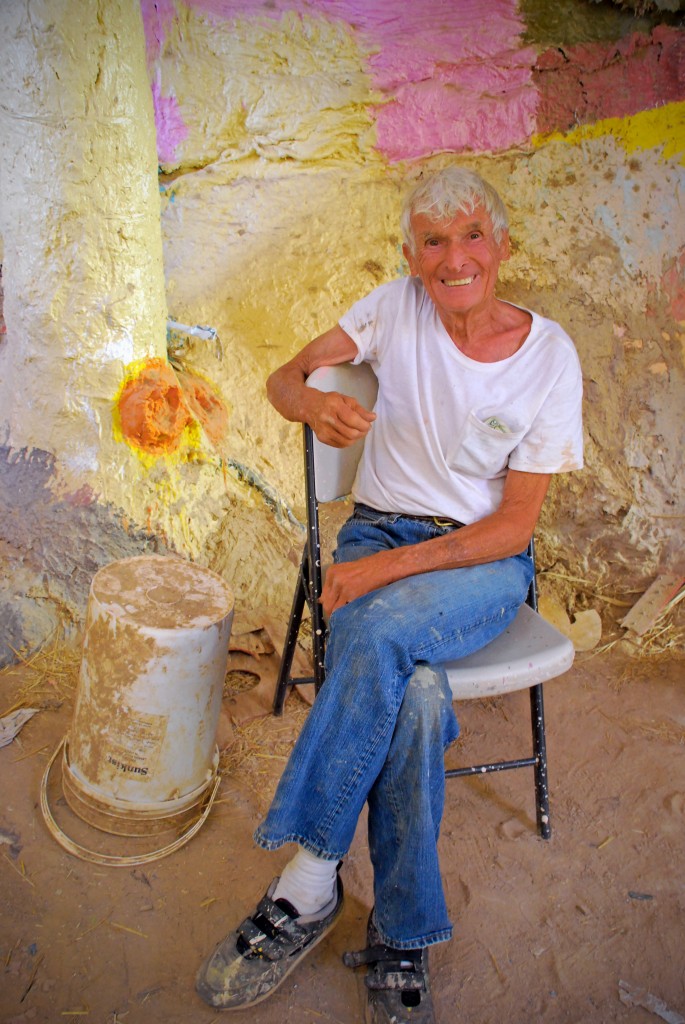
I overlooked the flowers on my mother’s grave
For thirty years upon my life she was my slave
And I overlooked the flowers on my mother’s grave
And sometimes now I wish I did behave.
–A song written by Leonard Knight, sung for Patrick Rea
Leonard is sitting at a table in a diner with his friend Patrick Rea. Patrick met Leonard when he visited the mountain with his daughter after watching Into the Wild. Leonard gave them both the standard tour, told them his story, and sang them some songs. After leaving, Patrick soon realized that Leonard would make a fascinating subject for a feature film or documentary, and from 2008 until 2012, he spent hundreds of hours with Leonard documenting his work, listening to his message, and looking for the deeper story behind his life. Patrick recently completed a short documentary, The Love Story of Leonard Knight, and he is still working on getting his feature film funded.
In this video, Patrick and a few people close to Leonard have taken him out to a restaurant, where Leonard can relax without having to be quite as “on message” for his frequent visitors. Patrick asks Leonard about his childhood.
“I used to skip school all the time. I wouldn’t go to school when I was in fifth grade. I just quit. I just couldn’t seem to.”
“What did your parents say about you skipping school?” Patrick probes.
“Well, they’d try to spank me and whip me. And my poor mom would just cry over me, ‘We want you to learn something in school Leonard!’ I was such a nuisance. But they always put up with me with love.”
Patrick told me some of what he had learned of Leonard’s childhood. Leonard was the fourth of six children born on his family’s 32-acre farm in Shelburne Falls, Vermont. He didn’t fit in with the other kids at school and had a terrible stutter that he was teased for. He preferred his personal fantasy world–reading comic books and fantasizing about being a super hero–to playing with the other children. He would spend time alone in the woods on his family’s property and swing from tree to tree, his feet never touching the ground. He taught himself his own version of what he understood of karate, gleaned from his comics. He would go around chopping at trees to break them.
“At school the other kids didn’t want to play with him because he was weird,” Patrick says. “So he would just rub the outside of his hand up against the brick wall to toughen it and callus it up so that later he would be able to chop branches without hurting his hand. He was this extremely oddball kid who didn’t fit in, who didn’t understand anything the teacher was talking about, who lived in this fantasy world.”
As an adult, Leonard was increasingly troubled. He dropped out of high school in his sophomore year, but couldn’t find steady work. He was drafted into the Korean War at the age of 20, served as a tank mechanic and was eventually promoted to motor pool sergeant. Back home from the war, he returned to a rudderless existence, going from job to job, drinking too much.
“He was just this guy who kind of couch surfed between his sister and brothers’ couches, and he became an alcoholic, and he hated God,” Patrick explains. “He described himself as this horrible person. I don’t know if he was the kind of guy to walk into a bar and get into a bar fight. He was tight-lipped about it, but I get the impression that there was a different side to him, like a Jekyll and Hyde thing.”
My heart breaks for the young, lonely Leonard I imagine when Patrick tells me this. Troubled, a failure, out of control. How often do people recover from this kind of darkness, I wonder? Not often. Is this how bad it needs to get for someone to decide to spend his life living in the desert, alone, painting a mountain full of prayers for God and the world to see?
“He was in his 30s and didn’t have a wife, didn’t have a degree, didn’t have a job, didn’t have any money, didn’t have anything,” Patrick says. “Life wasn’t going very well. That’s when he cried out to Jesus and asked him to change him. And that was the beginning of that.”
Is this how bad it needs to get for someone to decide to spend his life living in the desert, alone, painting a mountain full of prayers for God and the world to see?
A few nights after talking to Patrick I have a dream of Leonard Knight. We’re sitting side-by-side in two plastic chairs in his museum, right in front of the huge GOD IS LOVE mural that has rainbow stripes thinly painted between the letters. This is my favorite spot at the mountain. In real life, it’s cooler that anywhere else, insulated by thick walls of adobe and hay. A hammock and chairs left out in front of the wall mural lends a different sense of Leonard’s presence, something that feels more deeply intimate. In the dream, we chat and laugh, swing out legs like pendulums dangling from the seats of our chairs, or we fold our knees and press the backs of our thighs up against our chests. I’m the age I am now, and Leonard is the same age he was when I last saw him alive, but in my dream I also feel as if we’re at the same time children, as if he’s my little brother and I want to protect him, want to keep him safe from the awareness of how much he’s been mocked and misunderstood–both as a child and as the grown man who made a mountain. I want to protect him from knowing how much of it has crumbled since he’s been away.
When I last visited the mountain in September 2013, Leonard was still alive, but he was living off-site at the care facility. What I always felt at the mountain when Leonard was there I didn’t sense there anymore. Through the corridors and anterooms of the museum, in the splatters and drips of paint recently touched up, at the alcove beneath the left side of the mountain, standing on the painted ocean floor looking up at the signs proclaiming Jesus’ name and fire and God’s love, I used to feel a presence. Patrick mentioned this too, said that it’s something he’s heard from people who have visited the mountain lately. Depending on your beliefs, the feeling of presence is either God, or Leonard’s spirit, or the aura of the mountain, or some combination of these. To me it was the feeling you get in someone’s home, when you see their pictures on the wall and the domestic scenes they leave in medias res, and you get the sense of the family that dwells within. Salvation Mountain used to feel like that, but bigger, which makes sense considering that practically everything Leonard cared about toward the end of his life was literally written on its walls.
Now the feeling is one of absence. In the Imperial Valley, throughout the desert that surrounds the Mountain and the nearby Slabs, there are houses that no one lives in, abandoned, emptied of their usefulness and of the presence that used to dwell within. The Salton Sea is full of ruins, almost entire communities converted to ghost towns in the wake of fluctuating sea levels and increasing salinity. I’m one of many photographers and voyeurs drawn to the mystery implied by these modern ruins. I walk through empty doorways and peek through broken windows for clues left behind, trying to reconstruct a narrative using the leavings of someone else’s life: rotting old couches, photographs strewn across a linoleum floor, a suitcase left half packed.
Salvation Mountain feels like those old ruins to me now. I still expect to see Leonard emerging from the back of his pickup truck to offer me a tour. The relics from his life are still here–a plastic chair in the alcove of his museum, a Bible in the Hogan left open to Habakkuk and Zephaniah as if someone was just interrupted in the middle of a study. The grounds still fill with visitors, but I feel that we are now all chasing a phantom. What does the mountain mean now, without Leonard to put it in context, without the friendly smile and greeting as an example of what faith like his means in practice as well as theory? I don’t know.
A nonprofit group, Salvation Mountain, Inc., was formed in 2012, after Leonard was moved to a long-term care facility, to work towards preserving the mountain. In the past few years, the board of directors for the nonprofit–which includes members of Leonard’s family, his friends, and neighbors from Slab City–have organized volunteer work parties to touch up cracks and fading paint. They have also hired a series of caretakers to live on the site full-time. Since my last visit, the slide on the front of the mountain has been repaired and repainted, and some of the cracks filled in with fresh adobe and paint. But it’s unlikely that anyone will be able to match the attentiveness of Leonard, who worked on it seven days a week, often eight to ten hours a day. To ask that kind of dedication from a hired worker seems at best unrealistic, and at worst–considering the harsh environment and the extreme isolation that Leonard lived in for years–cruel.
At my last visit, I lingered for a long time in the Hogan. Since the last time I had visited, back in 2010, visitors had started leaving behind mementos. They now covered every surface, crowding out the relics that Leonard himself had left there. Photographs, credit cards, drivers’ licenses, high school student ID cards, frequent buyer cards for coffee and frozen yogurt. There were personal letters, notes written to Leonard, prayers on scraps of paper or on the backs of photos or even written right into the walls with Sharpie. It reminded me of the Dia de los Muertos altars I used to see around parts of San Diego, altars to honor dead loved ones. Or like a shrine to a saint.
I found clam shells. A purple key. A note with childish handwriting in red crayon: DAIKI ♥ MAYU 9/1/2013. A Pep Boys debit card made out to Victor Garcia. A postcard with a photo of a fuzzy tarantula on one side, and on the back, in blue ink: For my mother, that her surgery goes well. For Zach, who is turning 20 and for whom I wish only the very best. For Zak, that he keeps making music and art, that he won’t drink so much and will find a way to be happy. And for Emily, with whom I am so happy to be traveling with.
What do all of these people mean by leaving behind these pieces of themselves in this place? To whom are they reaching out–Leonard, God, or each other?
I find a black and white photograph of a pretty young woman with straight dark hair and glasses, wearing a bow-tie and a button-down blouse. On the back it reads: This photo belongs to a fabulous photographer named Grace Hughes. Please return to 986 Bathurst St. at a store called A Nerd’s World. You can meet her there, and other cool nerds.
This seems like a message in a bottle, so I look up the address and find a graphic design, web development and photographic boutique. I send Grace an email on the company website’s contact form. I ask her why she was at Salvation Mountain, why she left the photo behind. She replies: “My husband and I watched a documentary on Vice about Slab City and decided to take a memorable road trip from Toronto through Route 66 and stop by other interesting places like Slab City. The mountain was amazing to see in person, just the thought of someone or some people creating it was touching, filled with love, and a sight like no other. The last place I looked in before we left was the place of all the photographs and other things left behind by visitors. I don’t know who all those people are, but somehow leaving something behind made me feel like we were all connected–like a little cave of people’s positive energy.”
Maybe there is still a presence left at the mountain, but if so, perhaps now it has more to do with the people that are drawn there than it does with Leonard Knight. What I don’t know is whether that’s a good thing or a bad thing.
Patrick worries that Salvation Mountain might remain, but that the message that Leonard worked for decades to spread will be lost or even perverted. Specifically, Patrick worries that the religious content of that message is being diluted to a more secular version. Leonard talked about love almost exclusively, but the source of that love, as he saw it, was rooted in his concept of God and Jesus. Patrick tells me that now, without Leonard at the mountain to maintain the purity of his testament, that “Love” is being reinterpreted in broader spiritualistic, rather than Christian, terms by visitors and by some of the people working to preserve the mountain. Secular fans of the mountain embrace the art itself and the universal love part of Leonard’s message. Leonard himself, Patrick fears, is in danger of being turned from a Christian evangelist into a “New Age love guru.”
“A lot of Christians are praying that the mountain’s brought down,” Patrick tells me. “A lot of people are afraid that it’s going to be turned into an idol in the Biblical sense, that it will represent the opposite of what Leonard believed in. I don’t know what to hope for. Obviously if the mountain is turned into something that is used to undermine everything Leonard worked for, then Leonard would be the first one to say tear down the mountain.”
I see a place for people from across the world to share a space that suggests to them, in huge, boldly printed letters, LOVE.
Patrick speaks not just as a Christian, but as Leonard’s friend. I was not Leonard’s friend, and I’m not a Christian, and I don’t know what to hope for either. I worry that I might be part of the problem that Patrick describes, that I am missing the point. Because when I visit the Mountain, I’m not visiting for the Bible verses, for the repeated references to Jesus and God. They don’t bother me, but they’re not what I come for. They’re not what I see.
What I see is a defiant and colorful explosion of flowers and waterfalls in the midst of a hot and desolate landscape. I see a brave expression of individuality in a hostile and indifferent environment. And now, as the Mountain currently stands even in its deteriorating state, I see a place for people from across the world, from different faiths or with a lack thereof, to share a space that suggests to them, again and again, in huge, boldly printed letters, LOVE. To me, at least for now, that is worth it.

